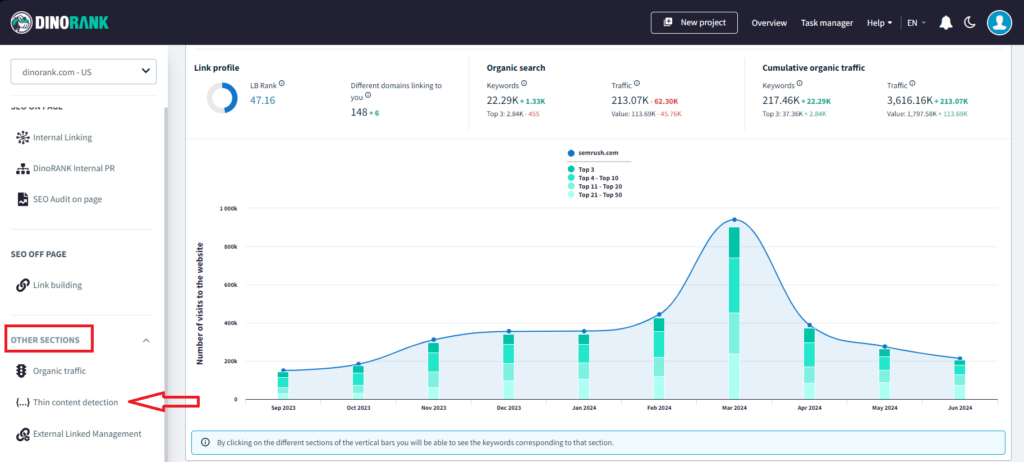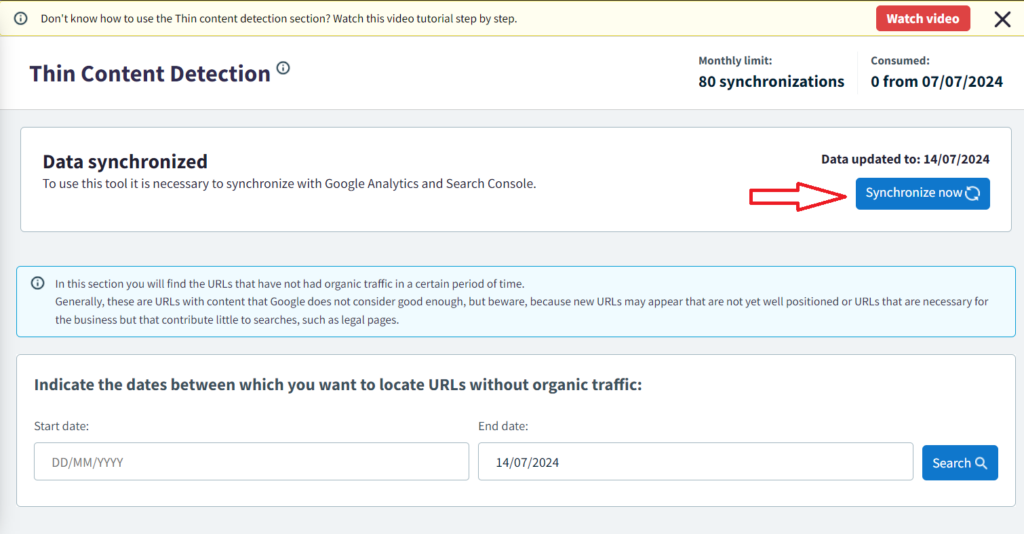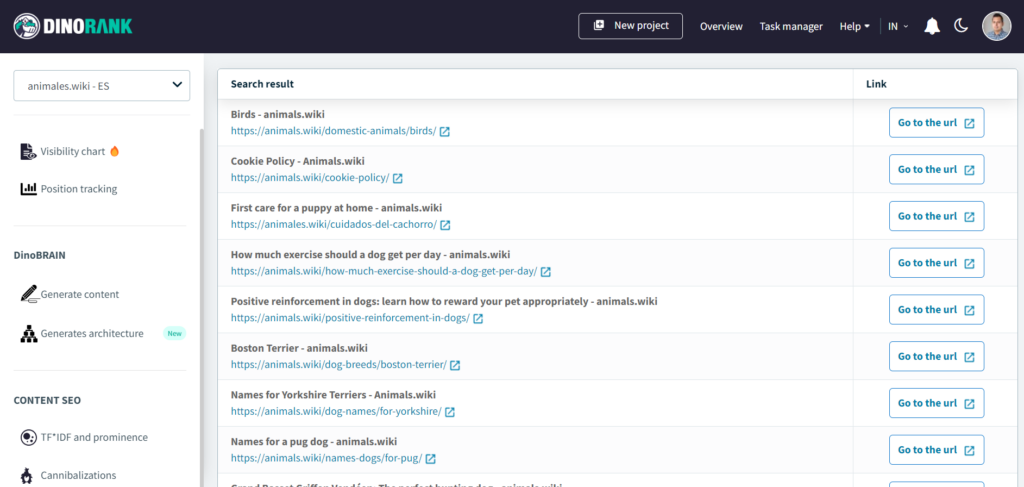Google’s algorithm is continuously refining its guidelines to provide better results to users who perform searches on its engine.
In recent years, it has been particularly focused on rewarding high-ranking positions to content that best addresses the user’s search intent (preferably quickly).
Similarly, if your content is of low quality, it may be flagged as thin content, and the consequence could be a negative impact on your website’s ranking (even stopping it from improving).
In this article, I’ll teach you a method to detect it in time and several solutions to fix it. Take note:
What is Thin Content SEO
Thin content refers to all low-quality content that doesn’t provide any value to the user. Sometimes, it’s also called “junk content.”
For Google, the most important thing is that users are satisfied when using their search engine. To achieve this, they need to find the best answers to their queries in every search.
Because of this, its algorithm looks for and penalizes URLs that do not answer the user’s questions or queries and, therefore, do not meet its standards.
This has been a practice enforced since 2011, with the introduction of the Panda Algorithm, but it has become even more significant over the years with the increase in online competition.
To detect it, search engines measure aspects such as bounce rate or average session duration. If these metrics are excessively low on any page of your website, it might be categorized as thin content and, in the worst-case scenario, be de-indexed by Google.
If you have automated content on your website, it is likely to be thin content.
Automated content that webmasters and niche site creators typically publish without adequate SEO knowledge includes:
- Unreviewed automatic translations.
- Spun texts where keywords are inserted without adapting them to the content.
- Rehashed content created by Artificial Intelligence.
You must be very careful with this type of black hat SEO strategy that tries to deceive Google and users, as you are likely to be detected and penalized if not executed correctly.
Why You Should Avoid Thin Content on Your Website
Thin content has several negative consequences:
- SEO decline
- Increased bounce rate
- Lower conversion rate
SEO Decline
Having a large amount of thin content on your website can severely harm the overall SEO ranking of your domain; it can lead to a significant drop in traffic and visibility.
Increased Bounce Rate
Poor content will always have negative consequences, such as a high bounce rate.
Ultimately, if users visit your site and don’t find value in your content, they’ll leave your website within seconds (hello pogo-sticking).
Lower Conversion Probability
The final consequence is that with thin content, you’ll achieve a much lower number of conversions than if you create valuable content.
If you don’t receive traffic or if the little traffic you do receive leaves your site without making any conversions, your project won’t be profitable, so in such a situation, it might not be worth keeping it operational.
What Google Considers Thin Content
These are the types of content that the search engine usually flags as having little or no value for users:
- Duplicate content
- Content lacking necessary depth
- Automated content without review
- Pages crammed with ads
- Affiliate pages without additional value
Next, I’ll explain in more detail what each of these entails:
Is Duplicate Content Thin Content?
Yes, and in fact, it’s one of the things Google penalizes most severely because, in many cases, it’s content ‘stolen’ from other websites.
It doesn’t matter if it’s entire pages, some paragraphs, or isolated sentences. It’s the same as taking content in one language, translating it to another, and pasting it on your website.
But this error doesn’t occur only between different domains. Sometimes, this duplicate content can appear even between pages on your own site, when, out of ignorance, the same content is published on two or more different URLs.
Is Short Content Thin Content?
This aspect is relative. There’s the eternal belief that for content to be rankable, it must exceed 300 words, but this will vary depending on the type of content you write.
Regarding Length, Keep in Mind That:
Whether you generate short or long content, length won’t be a determining factor for Google to assess whether it’s quality content.
Quality is determined by whether the content is useful to the user and meets their search intent.
Let’s take, for example, the description of a product page in an ecommerce site. It’s rarely long content, but that doesn’t mean it’s content that doesn’t provide value to the user.
As long as it’s optimized, providing quality information, and naturally including keywords, it will be content with the potential to rank.
Occasionally, it’s pointless to try to reach 300 words on product pages. You would only overwhelm the reader, causing them to leave without making a purchase.
Unreviewed Automated Content
The advent of artificial intelligence has led to the development of a wide variety of automated content generation tools.
Although Google does not penalize content simply because it is AI-generated, it is true that if you don’t use the right intelligence or perform a manual review, your content might not be considered valuable and could end up receiving a penalty or simply be ignored.
I recommend opting for SEO-oriented AI models that generate valuable content that will rank well.
Pages Full of Ads
Pages that hinder user experience by showing ads that make it difficult to view the content and can even make it impossible are also considered thin content by Google.
If you have a website where part of your revenue is based on displaying ads, make sure they do not prevent readers from properly consuming the content.
Affiliate Pages Without Value
If you own a niche website where you aim to earn income through affiliate links, make sure to offer value to the user beyond just trying to drive clicks on the links.
Otherwise, the site will be classified as thin content and, in the worst case, this could lead to complete deindexation of the domain by Google.
How to Find Thin Content Within Your Website
DinoRANK has a module dedicated exclusively to detecting potential thin content cases.
To show you how easy it is to use, I’ll give you an example with a project whose domain is megustaverlonline.tv, which aims to be monetized through Google Adsense advertising.
Let’s follow these steps:
1. Detect if its traffic is dropping
First, I will analyze the website’s visibility graph to understand its traffic data:

As you can see, since the end of 2023 there has been a free fall, considering that it historically had almost 30k visits/month, down to just 300 organic visits per month.
This project has generated automated content for years. Additionally, it contains different pages where the sole aim is to get the user to click on affiliate links, without offering any real value.
Based on this, the suspicion that thin content may be one of the main reasons for the drop is more than justified.
2. Sync Your Website with DinoRANK
I will go to the Thin Content Module, where I will try to find out which pages have caused this drop.
In this module, DinoRANK directly tells you which pages are the least relevant on your website, so you can work on them.
To use it, you just have to sync the tool with Google Search Console and Analytics; DinoRANK will cross-reference the data.


3. Examine if There are URLs with Thin Content
In the next step, DinoRANK will ask you to enter a date range to search for URLs with no traffic, as you can see in the image above.
Since the visibility graph indicated that the drop started in October, I will set that as the start date. For the end date, I will set today’s date.
By clicking search, DinoRANK provides a list of potential pages with thin content along with their respective meta titles and URLs:

Clicking on any of the URLs in this list will open a new page where you can view more detailed aspects of the page such as:
- Internal linking.
- Inbound and outbound links.
- Backlinks that the URL has.

We see that the URL does not present any obvious technical SEO defects, so it might be categorized as thin content because its content is too poor.
I will click on its URL to analyze the page content.
Once inside, I find that in this article the content is poor and lacks depth, banners appear constantly, and there are large blank spaces that disrupt the reading experience:

Based on this, we can say that it can indeed be a real case of thin content, which we were able to easily detect thanks to DinoRANK.
Continue reading to learn how to handle these cases or try Dinorank now.
What to Do with the Thin Content on Your Website
After discovering the URLs with thin content on your site, the big question arises: what can I do with them so they don’t harm my website further?
Don’t panic because I’m going to explain what you can do to fix it:
- Improve the content
- Redirect
- Use noindex tag
- Delete the page
Improve the content
If the page in question aims to rank for an interesting or business-related keyword that you would like to appear for, perhaps the best solution is to optimize the content in question so that Google removes the thin content label.
To do this, look at the well-ranked posts from the competition and try to identify what they are doing to address the search intent that your page is missing.
I recommend using this feature:
When it comes to improving the organic ranking of content, I use the TF*IDF module of DinoRANK, which allows me to know the terms and keywords that my competitors are using.
This way, you will enrich your content with greater semantic value.
I recommend this action when you’re using a URL that you want to keep.
Redirect
It’s often used to solve duplicate content or cannibalization issues.
Noindex Tag
The noindex tag is ideal to apply when the URL with thin content is not meant to rank for any keywords, but it needs to remain on the website.
By implementing the noindex tag, we prevent Google’s robot from entering that page and categorizing it as thin content. This way, we can keep the URL without harming the site’s ranking.
This is very useful for privacy policy pages, shipping terms, etc.
Delete the Page
If the page has no utility on your website, the best thing to do is save yourself the headache and get rid of it.
It’s the quickest way to solve thin content, but any time spent on generating that URL will be wasted.
But watch out! Before deleting it, make sure it doesn’t have any incoming internal or external links:
- If you have internal links from other content, edit them to point to other active URLs on your site.
- If that URL has backlinks pointing to it, contact the webmaster in question to update the link.
How to Avoid Having Thin Content on Your Website
- Analyze the search intent carefully.
- Develop original quality content.
- Follow a proper planning strategy.
The best way to deal with thin content is by preventing it. As the saying goes, an ounce of prevention is worth a pound of cure, and it applies here as well.
To achieve this, you can take a series of actions to avoid making this mistake unintentionally:
Analyze the Search Intent Carefully
Something that both users and Google value is that the content they visit answers their questions and concerns in the best possible way.
To do this, ask yourself what you would like to find on a page like yours. If you manage to do it correctly, Google will reward you with better rankings.
Develop Original Quality Content
Creating original and quality content will help you avoid potential duplicate content issues.
Additionally, Google’s algorithm is designed to identify and prioritize content that offers significant value to users, making it a way to stand out from the competition.
Follow a Proper Plan
By following a good plan, you’ll be able to determine if you’ve addressed a search intent before a potential case of keyword cannibalization arises.
This way, you ensure that you always create fresh content for your page and avoid wasting time.
Now You Can Combat Thin Content
As you can see, when creating content, it’s important not to get too caught up in the technical aspects without paying enough attention to the text itself.
Low-value content can harm your website more than forgetting to add a keyword.
Fortunately, you know that thanks to DinoRANK, you can identify thin content and also fix it quickly and easily.
All that’s left is to decide how to act in each case and follow a prevention strategy to avoid it in the future.

